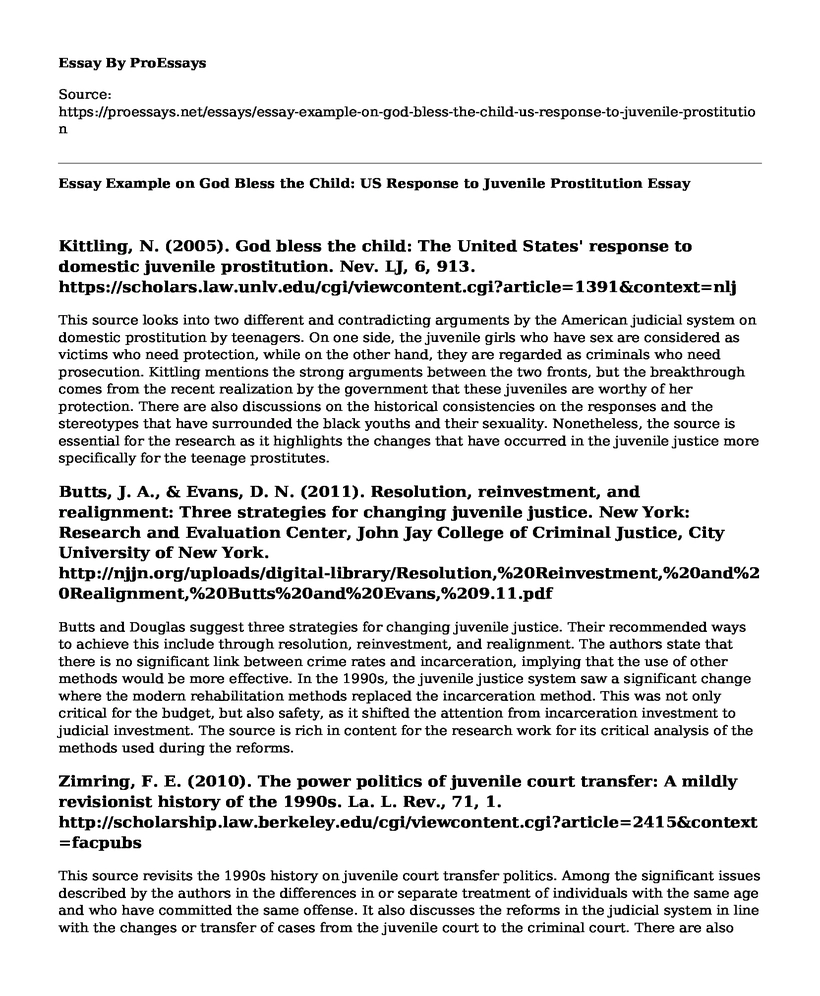Kittling, N. (2005). God bless the child: The United States' response to domestic juvenile prostitution. Nev. LJ, 6, 913. https://scholars.law.unlv.edu/cgi/viewcontent.cgi?article=1391&context=nlj
This source looks into two different and contradicting arguments by the American judicial system on domestic prostitution by teenagers. On one side, the juvenile girls who have sex are considered as victims who need protection, while on the other hand, they are regarded as criminals who need prosecution. Kittling mentions the strong arguments between the two fronts, but the breakthrough comes from the recent realization by the government that these juveniles are worthy of her protection. There are also discussions on the historical consistencies on the responses and the stereotypes that have surrounded the black youths and their sexuality. Nonetheless, the source is essential for the research as it highlights the changes that have occurred in the juvenile justice more specifically for the teenage prostitutes.
Butts, J. A., & Evans, D. N. (2011). Resolution, reinvestment, and realignment: Three strategies for changing juvenile justice. New York: Research and Evaluation Center, John Jay College of Criminal Justice, City University of New York. http://njjn.org/uploads/digital-library/Resolution,%20Reinvestment,%20and%20Realignment,%20Butts%20and%20Evans,%209.11.pdf
Butts and Douglas suggest three strategies for changing juvenile justice. Their recommended ways to achieve this include through resolution, reinvestment, and realignment. The authors state that there is no significant link between crime rates and incarceration, implying that the use of other methods would be more effective. In the 1990s, the juvenile justice system saw a significant change where the modern rehabilitation methods replaced the incarceration method. This was not only critical for the budget, but also safety, as it shifted the attention from incarceration investment to judicial investment. The source is rich in content for the research work for its critical analysis of the methods used during the reforms.
Zimring, F. E. (2010). The power politics of juvenile court transfer: A mildly revisionist history of the 1990s. La. L. Rev., 71, 1. http://scholarship.law.berkeley.edu/cgi/viewcontent.cgi?article=2415&context=facpubs
This source revisits the 1990s history on juvenile court transfer politics. Among the significant issues described by the authors in the differences in or separate treatment of individuals with the same age and who have committed the same offense. It also discusses the reforms in the judicial system in line with the changes or transfer of cases from the juvenile court to the criminal court. There are also discussions on the age groups for the various courts and the statistics on how the trends changes with the changes in ages of the offenders. The discussions on juvenile court transfer are of great value to the research question as it also touches on the 1990s changes in the system.
Torbet, P., & Szymanski, L. (1998). State Legislative Responses to Violent Juvenile Crime: 1996-97 Update. Juvenile Justice Bulletin. https://files.eric.ed.gov/fulltext/ED434979.pdf
A report on the states legislature response to violent juvenile crime with a provision of cases and waivers attached to them. There are also findings from an analysis of laws passed in the late 1990s targeting severe juvenile violent crimes. The study found in its results that states have continuously modified the criteria in which the offenses are transferred. The impacts caused to the juvenile courts' dispositions are also discussed by the authors here, and the continued emphasis supplemented by the courts on secure programs for correction involving community interventions stressing on offender accountability and safety of the public.
Reynolds, M. O., & Director, N. C. P. A. (2000). Crime and punishment in Texas in the 1990s. National Center for Policy Analysis. Retrieved from http://www. ncpa. org/pub/st237. http://www.ncpathinktank.org/pdfs/st237.pdf
The source is very rich in content for this given research, with focus on the 1990s Texas juvenile criminal justice system. It is in the 1990s that crime sharply fell in Texas regardless of the several political criticisms for their criminal justice system. The state's approach to criminal punishment was opposed, especially for the death penalty and the rights for carrying concealed weapons. However, the much-criticized policies yielded the best fruits since it was in this period when there were the lowest rates of murder falling by 10% in 1990 alone. The topic of crime and punishment in Texas adds direct content to the research topic, making it one of the essential sources for this work.
Cite this page
Essay Example on God Bless the Child: US Response to Juvenile Prostitution. (2023, Feb 12). Retrieved from https://proessays.net/essays/essay-example-on-god-bless-the-child-us-response-to-juvenile-prostitution
If you are the original author of this essay and no longer wish to have it published on the ProEssays website, please click below to request its removal:
- Ethical Dilemmas That Could Arise in a Diabetes Advocacy Campaign, and How You Could Manage It?
- Trends in Crime Policy in the United States Paper Example
- Crime and Justice: A Systematic Analysis
- Special Needs Prisons: Addressing Inmates' Unique Needs - Essay Sample
- Culture: Identity, Beliefs, and Day-to-Day Life of a Social Group - Essay Sample
- Essay Example on Parents' Uphill Task: Ensuring Smooth Home Care for Kids with Tracheotomies
- Paper Example on Canada's Economy: Service vs. Goods-Producing Sector







